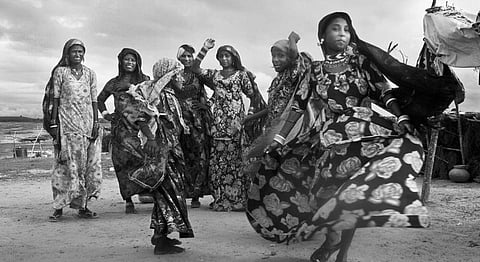
- HOMEGROWN WORLD
- #HGCREATORS
- #HGEXPLORE
- #HGVOICES
- #HGSHOP
- CAREERS
- ABOUT US
- CONTACT US

Scorching sands, stale winds, temporary homes and uncanny traditions; the Kalbelia are not unfamiliar to these facets. Also commonly recalled as migrating gypsies, the Kalbelia are nomadic snake handlers that largely reside on the outskirts of Pushkar, Ajmer, Chittorgarh and Udaipur district. “Kal” is common glossary for death, and the name “Kalbelia” suggests the tribe’s dominance over poisonous snakes, and the fear of death.
The Kalbelia trace their ancestry from Kanlipar, who was the 12th disciple of Guru Gorakhnath, the founder of the Nath tradition. The identity of the gypsy folk is deeply rooted in their religion and their beliefs; they are followers of Guru Kanipa, one of the nine masters who resides on Mount Kailash, alongside Lord Shiva.
According to Hindu Mythology, Lord Shiva offered a bowl of all the poison of the universe to Kanipa, who consumed it all at once. Impressed by his dedication, Lord Shiva promised Kanipa that the world would take care of him and his descendants.
This promise included the right to beg, which explains the ability of the Kalbelia to have dominion over poison and poisonous creatures, as well as to beg unabashedly, as direct disciples of Kanipa. This mythological occurrence also explains the traditional occupation of the Kalbelia as snake charmers, snake catchers and venom traders.
Some members of the community are also healers who, while playing into their Tantric associations, are capable of curing poisonous snake bites. Their remedies largely include mantras, as well as an unusual mixture of herbs and camel urine, whose bitter taste causes the victim to vomit, thus releasing their body of the poison. Over the generations, the Kalbelia have acquired a unique understanding of the local flora and fauna, and are aware of herbal remedies for various diseases, which is an alternative source of income for them.
Apart from their bizarre occupations and cultural norms, the western desert vagabonds are widely recognised for their Kalbelia dance form, which is an integral part of their identity. The women are skilled dancers, and their movements resemble those of a serpent- sensuous and graceful. Donned in black clothing, the dancers swirl to the rhythm of percussion, provided by the men folk using a variety of instruments such as the “been”, “dulfi” and “dholak”. The Kalbelia often sing songs inspired by stories from the folklore of Rajasthan, and this gypsy music is passed through the generations as a form of inheritance.
Despite their affinities with Hinduism, the Kalbelia hold one aspect that is high in contrast to those of most Hindu caste practices- they bury their dead, rather than cremating them. The tribal folk have elaborate post mortem rituals, often related to pollution, as well as the restoration of purity after death. This practice raises a lot of questions about the intellect and deeply rooted belief system of the Kalbelias, and its consequences on the community, due to the complexities of the rituals, both financially and socially.
The Kalbelia, who were once hired to entertain kings and Maharajas, are now struggling to preserve their culture. Despite their internal misunderstandings, disputes and struggles, the gypsy folk maintain a shared sense of identity and solidarity. The Kalbelia have a unique mechanism to cope with cultural change, and are pristine examples of the resourcefulness and flexibility of nomadic communities.
All photographs included in the article are credited to Christian Stejskal.
If you liked this article we suggest you read:
